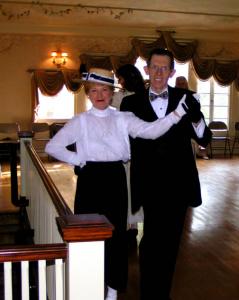In Defense of Ragtime Dancing
 As an organizer of vintage dance events, I have found something quite puzzling: Victorian, Regency, Roaring '20s and Swing Era themed dances have a lot of "traction", and if properly promoted and executed, do quite well but "Ragtime era" dances don't.
As an organizer of vintage dance events, I have found something quite puzzling: Victorian, Regency, Roaring '20s and Swing Era themed dances have a lot of "traction", and if properly promoted and executed, do quite well but "Ragtime era" dances don't.
Granted, there is a strong and very devoted Ragtime dance community, but it is a small community that tends to skew to the older end of the demographic spectrum (I include myself in that demographic), and is not enough to support large scale events on the scale of the Social Daunce Irregulars, or Jane Austen Evening or Avalon Ball.
On the face of it, this is a bit surprising. The music of the Ragtime Era is lively, fun and memorable. The dances are exuberant and easy to learn and the costuming is not nearly as complicated or difficult to fake as some other eras. In fact, in both the dancing and the costuming, it would be fair to say that the minimum level is quite easy to attain, but both the dance and costuming offer optional higher levels of complexity that can challenge and interest the most ambitious dancer or costumer.
We also don't lack for excellent musicians, and groups ranging from small combos to large brass bands who do a splendid job of bringing the early days of Tin Pan Alley to life.
The essential dance of the period is the "One-Step". With a step that is really nothing more than walking, it is the easiest ballroom dance you will ever learn (and learn in about a minute-and-a-half). I love the fact that, at a Ragtime dance, I can walk up to a wall flower, ask her to dance, and when she says "I don't know this dance" I say "Yes you do" and we then get up and do it, first time, perfectly. Freed from worries about the step, you can use it as a platform for all sorts of figures and improvisation. At a Victorian ball, I am much more wary of asking a stranger to dance since, alas, if you don't know how to waltz, you don't know how to waltz.
The other prototypical Ragtime dances, the Tango and Two-Step are almost as easy to learn as the One-Step, and are also, if danced with the right spirit, a great deal of fun. This is not to mention the downright goofy (but also easy to learn) novelty dances of the period, like the Cake Walk, Grizzly Bear or Turkey Trot.
And, for lovers of the Waltz -- it is still on the program and danced with all the grace and charm of earlier eras.
And yet, while a Victorian Dance, Jazz Age Dance, or Regency Dance (preferably with Jane Austen's name on it) can pull in around 300 or more people; a Ragtime Dance in a massive market like Los Angeles, is hard pressed to find anywhere near a third of that. It's a puzzlement.
The only explanation I can see is that people are reluctant to try it because they don't have a clear image in their minds of what is meant by "Ragtime Era". Thanks to films and TV, "Victorian", "Roaring 20s", "Jane Austen" etc. elicit a distinct visceral reaction -- people already have feelings about that era, and a significant number will have a sense that they want involve themselves in a celebration of that era. I don't think the same can be said about the Age of Ragtime.
I have to think that the problem is essentially one of marketing. My perception is that the music and the dance, when given a chance, can sell themselves; but the problem seems to be that people don't feel motivated to step outside the familiar and give it a try.
About the only connection most people make to the era is the movie "Titanic", and I have pondered using that as some sort of marketing tie in -- but somehow linking such a horrific tragedy to such an exuberant and joyful musical form just didn't seem right. Attempts to emulate the success Swing events have had linking themselves to World War Two, by linking Ragtime with World War One have also fallen flat, and perhaps it might have something to do with evoking a war so associated with futility and despair - or perhaps it's because to so many people the era, to include The Great War, is pretty much a blank.
So, the search for the right marketing "hook" continues -- working on the assumption that people would like it if they just tried it. I hope that is actually true.
By the way, when I say "Ragtime Era", I am talking about 1890-1920. The fact that I usually have to explain that seems to be part of the problem.
For those wondering of what I speak, here's a video from our last largish scale Ragtime Event: the "Aviators' Ball" in 2003.
